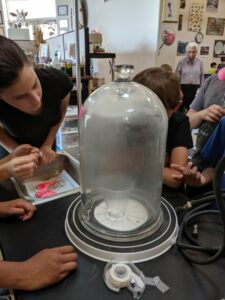New this academic year is the Science Club!
 This week, the students engaged with Dr. Vince Gutschick, teacher and Board Chair, who (literally) rolled out our vacuum pump, along with a large bell jar, several balloons, and a small Magdeburg sphere. We watched as a balloon suspended in the bell jar expanded to fill the volume as its internal pressure pushed out its membrane against the rapidly decreasing pressure in the bell jar.
This week, the students engaged with Dr. Vince Gutschick, teacher and Board Chair, who (literally) rolled out our vacuum pump, along with a large bell jar, several balloons, and a small Magdeburg sphere. We watched as a balloon suspended in the bell jar expanded to fill the volume as its internal pressure pushed out its membrane against the rapidly decreasing pressure in the bell jar.
We also boiled water at low temperature! Students learned that boiling means that the vapor pressure of water (set by its temperature) matches the air pressure on the water. There’s a lot of history of early exploring that used this fact to estimate land elevation.
Students had a ton of fun with the Magdeburg sphere – a split cast-iron sphere sealed against air leaks by a greased rubber ring. With normal air pressure inside and out, it’s easily pulled apart with little force- just enough to overcome the grease film.
A very simple way to demonstrate the effects of air pressure is the suck out the air and close the valve. A person can suck out about 1/3 of ambient air- at our elevation (1200 meters) that results in a closure force equivalent to weight of a 26 kg mass. Students tugged in pairs to split the sphere and eventually succeeded.
When we connected the vacuum pump to suck out all the air from the sphere, the force holding it together tripled. No team was able to part it, but they had great fun trying! Imagine the reaction of crowds to the original full-sized Magdeburg sphere demonstrated in 1654 by Count Otto von Guericke in the town from which it took its name; two teams of fifteen horses each could not pull it apart against the force about equal to the weight of a good-sized car.
 The Science Club will be meeting Wednesdays right after classes end at 4:10 PM.
The Science Club will be meeting Wednesdays right after classes end at 4:10 PM.




